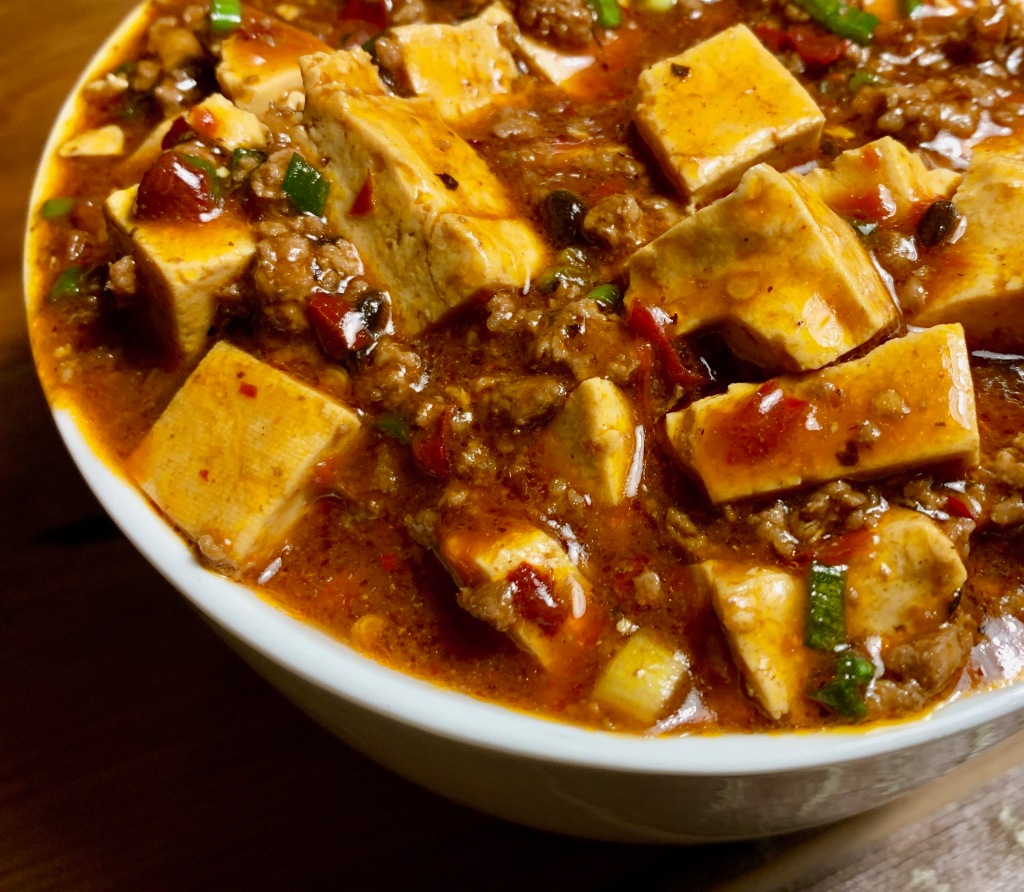This is a dish, much like Bolognese for the Italians, that has a strong foundation in traditional preparation – which is essential to understand before tinkering around with it. This recipe represents eight years of tweaking and substituting, before finally arriving at what I love personally.
A few things to know:
The Condiments:
All of these are pretty standard in the Chinese pantry, but there are a few ways to up your game here. The most important is sourcing Shaoxing wine with no salt added – the flavor is vastly superior and will reflect in your Mapo Tofu. The choice of soy sauce is all about what you prefer, I like the double fermented style because of the beefiness of the dish. It’s hard to find good Sichuan chili oil, so I use the soaking oil from jarred black beans with chilis and add it to the dried black beans (I prefer both the flavor and texture to the jarred ones) to make the paste with ginger and garlic. In choosing a Doubanjiang, try to find one that utilizes broad beans instead of soybeans – as with all of these condiments a little research goes a long way (Or, in my case, I was lucky enough to have that research done mostly by my friend, Jon Dietz). The ketchup, while it may seem unorthodox, is a good thing. Lastly, buy high-quality Sichuan peppercorns and grind them yourself for maximum effect.
The Meat & Tofu
For the longest time, I made this dish with ground pork (and chicken stock in the sauce), until one day I randomly tried ground beef and much preferred the outcome. This is a good use for the high-quality ground beef that is often a bit lean to use in things like meatballs, but perfect here because there are plenty of other sources of fat. I recommend Heiwa Tofu because it is delicious and made locally, so obviously, this may vary for you. What will not differ is that the better the quality of tofu, the better your Mapo Tofu will be.
The Rice
Many people would find my use of coconut rice downright appalling – and I am comfortable with that. To me, the buttery, luxurious style of the rice is the perfect foil for the many levels of spicy brought on by the Mapo Tofu. This being said, I am still happy eating the dish over plain steamed rice, as that is the way it is probably meant to be enjoyed.
1 lb. High Quality Ground Beef
1 Package Firm Tofu, Preferably Heiwa Brand
3 Tbl Fermented Bean Paste with Chilis (Doubanjiang)
2 Tbl. Fermented Black Beans, Rinsed
1 Tbl. Minced Garlic
1 Tbl. Minced Ginger
1 Tbl. Sichuan Chili Oil
1 Bunch Scallions, Chopped
2 Tbl. Peanut Oil
Sauce
1.5 Tbl. Shaoxing Cooking Wine (See Note)
2 Tbl. Rice Vinegar
4 Tbl. Double Fermented Soy Sauce (or Black Soy)
1 Tbl. Sesame Oil
1 tsp. ground Sichuan Peppercorn
1 Tbl. Sugar
1 Tbl. Maldon Sea Salt
1/3 Cup Heinz Organic Ketchup
1.5 Cups Beef or Veal Broth
3 Tbs Corn Starch
Coconut Rice
2 Cups Jasmine Rice
1 Can Coconut Milk
3 and ¼ Cups Chicken Stock
2 Shallots, Minced
3 Tbl. Kerrygold Butter
1 Tbl. Maldon Sea Salt
Dash of ground white pepper
1.
Get the rice going – heat the butter over medium high, add the shallots and cook for one minute. Add the rice and toast, stirring constantly, until it starts to turn opaque. Add coconut milk, chicken stock, salt, and pepper. Bring to a boil, cover, reduce heat to low. Cook for 23 minutes.
2.
Make the Sauce – Combine all ingredients and mix well. Set aside.
3.
After rinsing the black beans, mash them with the ginger, garlic, and chili oil with a fork
4.
Squeeze tofu with paper towels to remove as much moisture as possible. Dice into ½ inch cubes and sprinkle with salt. Set aside.
5.
Heat wok on high and add the peanut oil. Now add the black bean mixture and stir fry for 30 seconds, before adding the ground beef. Breaking up the meat with the spatula, stir-fry until it starts to lose its pink, raw color. Add the fermented bean paste, keep stir-frying for another minute before adding the tofu, mixing everything up. Keep cooking for another minute or two, stirring constantly, before forming a well in the middle and pouring the sauce in. Bring to a boil, stirring to incorporate as it begins to thicken.
6.
Add the chopped scallions, stir, and adjust for salt & pepper. You want a tingling effect from the Sichuan pepper, and a heat from the chilies. This is particularly complimentary to the sweet coconut rice.
Add rice to bowl, add Mapo Tofu to that. Get to it, with some good friends and a bottle of Baijiu.
